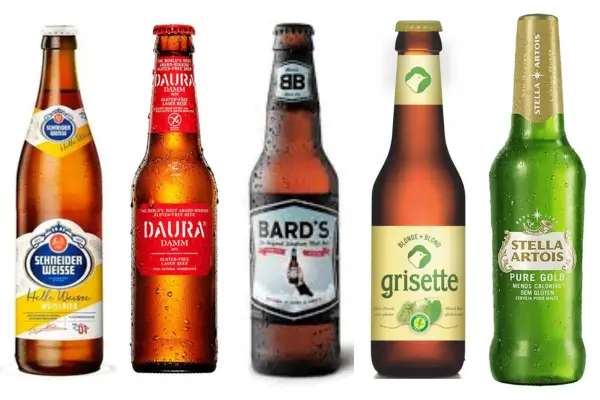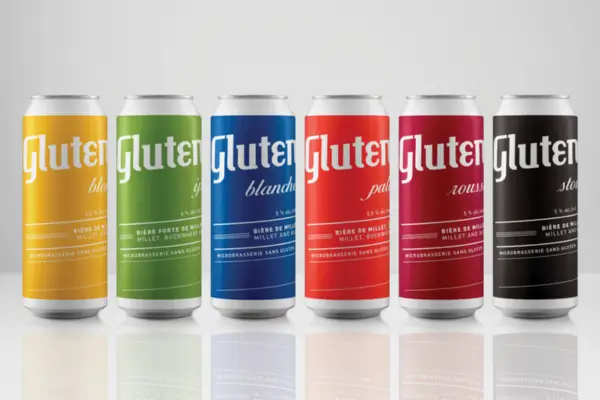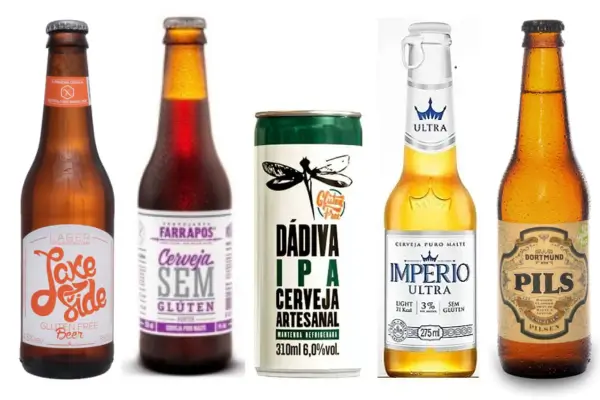If you follow a gluten-free diet or have a sensitivity to this protein, you’ve probably asked yourself: does beer have gluten?
The quick answer is: yes, most beers contain gluten.
But the good news is that there are excellent safe and tasty alternatives on the market!
In this article, we’ll explain why traditional beer contains gluten, who should avoid it, and how to choose gluten-free options without giving up the pleasure of a good drink.
Why Does Beer Contain Gluten?
Gluten is a naturally occurring protein typically found in grains such as wheat, barley, and rye.
Because beer is primarily brewed with malted barley, it ends up containing gluten.
Additionally, this protein contributes to the stability of the foam and the texture of the beverage.
That’s why the presence of gluten is almost inevitable in traditional beers.
Who Should Avoid Gluten in Beer?
Although gluten is not harmful to most people, some groups should avoid it for health or personal reasons:
- Celiacs: Individuals with celiac disease cannot consume gluten as it triggers autoimmune reactions.
- Gluten-sensitive individuals: Some people experience digestive discomfort and bloating after consuming gluten-containing foods.
- Followers of gluten-free diets: People who choose to avoid gluten for health or lifestyle reasons.

Which Beers Contain Gluten?
Most traditional beers contain gluten due to the use of malted barley. This includes popular styles like:
- Pilsner – light, clear, and refreshing, but with malted barley.
- Lager – similar to Pilsner, also made with barley.
- IPA (India Pale Ale) – known for its strong bitterness and aroma, but it still contains gluten.
- Stout – dark, full-bodied, made with barley malt.
- Weissbier (wheat beer) – as the name says, made with wheat, which is rich in gluten.
Those who must avoid gluten should always read the labels carefully or choose beers that are clearly labeled as gluten-free.
How Are Gluten-Free Beers Made?
Gluten-free beers can be produced in two ways:
- Use of alternative gluten-free ingredients – Some beers are made using naturally gluten-free grains like rice, corn, buckwheat, or sorghum instead of barley.
- Enzymatic gluten removal process – Some beers go through an enzymatic process during fermentation that breaks down the gluten protein, reducing its presence.
How to Identify Gluten-Free Beers?
To ensure safety, pay attention to seals and label indications. Some common terms used by manufacturers include:
- Gluten-Free
- Sem Glúten (Portuguese for Gluten-Free)
- Gluten Removed – does not guarantee that the beer is completely free of gluten.
⚠️ Attention:
Beers with reduced gluten are not recommended for celiacs, as they may still contain traces of the protein. For these cases, always choose labels that state “100% gluten-free.”

Step-by-Step: How to Choose Gluten-Free Beers
If you’re looking for the ideal beer and want to avoid gluten safely, follow this practical guide:
- Check the ingredient list on the label – watch out for barley, wheat, or rye.
- Look for the “gluten-free” seal – especially important for celiacs.
- Steer clear of “gluten reduced” beers if your intolerance is severe.
- Check the manufacturer’s website – many brands detail their production process.
- Try different styles – there are gluten-free IPA, Lager, and Pale Ale versions!
- Ask for recommendations in specialty stores – they usually offer a good variety.
- Observe your body’s reaction – each person reacts differently.
Global Trend: More Gluten-Free Beers
With more people being diagnosed with celiac disease or gluten sensitivity, breweries are increasingly investing in safe formulas.
Countries like Canada, Germany, Spain, and the United States already offer a wide variety of gluten-free labels – and Brazil is starting to follow suit.
Many craft microbreweries already produce gluten-free versions, with surprising flavors and aromas, such as:
- Passion fruit IPA
- Lager with rice and spices
- Pale Ale with sorghum and molasses
This diversity is only growing, benefiting those seeking flavor and health in the same glass.
Internationally Recognized Brands
| Brand | Main Characteristics |
| Schneider Weisse TAP 1 | Wheat beer with gluten removed |
| Estrella Damm Daura | Spanish lager with low gluten content |
| Bard’s Gold | Made with sorghum, naturally gluten-free |
| Grisette Blonde | Belgian origin, officially gluten-free, with a light and refreshing profile. |
| Stella Artois Pure Gold | Pure malt, gluten-free, fewer calories |
| Glutenberg | Canadian craft beer, 100% gluten-free |

- Schneider Weisse TAP 1 (Germany)
Schneider Weisse TAP 1 is a German wheat beer known for its refreshing taste and fruity notes. Although wheat beers traditionally contain gluten, some versions undergo a gluten removal process to make them suitable for celiacs.
Estrella Damm Daura (Spain)
A Spanish lager brewed with barley, with gluten content reduced using a special technique. Safe for celiacs and internationally awarded.
- Bard’s Gold (USA)
One of the first 100% gluten-free beers in the US. Made with sorghum, it’s safe for gluten-intolerant and celiac individuals.
- Grisette Blonde Gluten Free (Belgium)
Light, clear, and refreshing beer, certified gluten-free. Bottle-fermented with 5.5% alcohol content.
- Stella Artois Pure Gold (Belgium)
A lighter version of the classic Stella: pure malt, gluten-free, with 17% fewer calories. Pairs well with light dishes and has a smooth, moderately bitter taste.
- Glutenberg Brewery (Canada)
A global reference in gluten-free beers. Made with naturally gluten-free ingredients like sorghum and quinoa. Totally safe for celiacs.

5 Brazilian Gluten-Free Beers to Try
If you want to try Brazilian brands, these options are excellent:
| Brand | Details |
| Lake Side Beer | First 100% gluten-free Brazilian brewery, light and refreshing taste |
| Farrapos Porter | Dark beer with chocolate and coffee notes, gluten-free |
| Dádiva IPA | Intense and fruity, with a strong bitterness, gluten-free |
| Império Ultra | Pure malt, gluten-free, lighter alcohol content |
| Dortmund Pils | Full-bodied, smooth with creamy foam, gluten-free |

- Lake side beer
Founded in 2012 in Passo Fundo, Rio Grande do Sul, this Brazilian brewery was the first to produce gluten-free beer in Brazil! Lake Side Beer Lager Gluten-Free is made through an exclusive protein breakdown process. Artisanally crafted, it offers a refreshing and light flavor, with a mild bitterness and a dry finish.
- Farrapos Porter sem glúten
Farrapos Porter Gluten-Free is a Brazilian Porter-style beer with gluten removed during fermentation through enzymatic degradation. It features the typical aromas and flavors of the style, with roasted malts, caramel, coffee, and dark chocolate notes.
- Dadiva Ipa sem glúten
Dádiva IPA Gluten-Free is a bold and gluten-free India Pale Ale. Also brewed in Brazil, it offers a unique, accessible flavor with intense bitterness and notes of yellow fruits. It’s a high-quality craft beer with 6% alcohol content.
- Império Ultra sem glúten
A Brazilian pure malt beer, gluten-free, with few calories and low alcohol content. Made with the purest water, imported pure malt, and Hallertau hops. An ideal blend of lightness and flavor.
- Cerveja Pils sem glúten
Launched by Dortmund Brewery in São Paulo’s interior. This gluten-free beer is bottom-fermented, full-bodied, golden-yellow in color, with good foam formation and mild malt aromas. It has 4.5% alcohol content and low bitterness (IBU:14).
Other Alternatives for Those Avoiding Gluten
If you want to explore gluten-free drink options, try:
| Beverage | Main Characteristics |
| Cider | Made with fermented apples, light and fruity |
| Alcoholic Kombucha | Refreshing, fermented, with mild alcohol |
| Wine | Red, white, or rosé – naturally gluten-free |
| Pure Distilled Spirits | Vodka, tequila, and rum – if grain-free |
Conclusion
If you need or choose to eliminate gluten from your diet, you don’t have to give up enjoying a good beer.
With so many gluten-free options available in Brazil and worldwide, you can drink safely and with pleasure.
But always read the labels and look for reliable certifications.
And you? Have you ever tasted a gluten-free beer?
See also:




